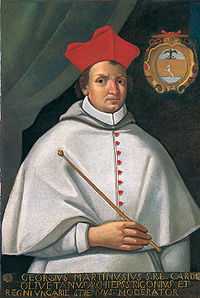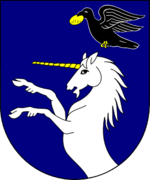George Martinuzzi

George Martinuzzi, O.S.P. (born Juraj Utješinović), also known as György Martinuzzi,[1][2] Brother György,[1][2] Georg Utiessenovicz-Martinuzzi or György Fráter[3] Hungarian: Fráter György; 1482 – December 16, 1551), was a Croatian nobleman, Pauline monk[4] and Hungarian statesman who supported King John Zápolya and his son, King John Sigismund Zápolya. He was Bishop of Nagyvárad (Oradea), Archbishop of Esztergom and a cardinal.
Biography
Martinuzzi was born in Kamičac, Dalmatia, southern Croatia. Since he usually identified himself as "Frater Georgius", he is known in Hungarian history as "Fráter György" or "Tux Frate". Martinuzzi was the son of Grgur Utješinović (English: Gregory Utissenich), a Croatian nobleman. He was named Juraj Utješinović but used his mother's name, Martinuzzi (a Venetian patrician family). Martinuzzi's sister, Ana, married Bartol Drašković and had three sons (one of whom was Croatian Ban (viceroy) and cardinal Juraj Drašković).
From age seven to twenty, Martinuzzi was attached to the court of John Corvinus. Later entering the service of the Zápolya family, he experienced military life under John Zápolya. Weary of life as a soldier, he entered The Order of Saint Paul the First Hermit and became a monk at age 28.
Martinuzzi's public career began in 1528, when his former patron Zápolya (now King of Hungary) was driven out by his rival, Ferdinand (later Emperor Ferdinand I) and made Martinuzzi his envoy to the Hungarian magnates. Due to Martinuzzi's tact and ability, John regained the throne in 1529 and "Fráter György" became his treasurer and chief counselor. In 1534 Martinuzzi became Bishop of Nagyvárad (Oradea), and four years later he concluded the Treaty of Nagyvárad with Ferdinand. This conceded the royal title and most of Hungary to Zápolya, who named Ferdinand his successor. However, Zápolya married and had a son in 1540 (shortly before he died).
John Zápolya named Martinuzzi guardian of his infant son John II Sigismund, who was elected King of Hungary by the Diet (with Martinuzzi as regent). The regent frustrated attempts by dowager queen Isabella Jagiellon to promote Ferdinand; the latter, contending that John II's election violated the treaty, invaded Hungary and an Austrian army reached the walls of Buda in 1541.

Martinuzzi took two drastic steps in response, arresting the queen and appealing to the Ottoman Empire for help. John Zápolya had requested Ottoman aid against Ferdinand; in return Hungary was an Ottoman vassal state, and Martinuzzi asked Ottoman Sultan Suleiman to defend his vassal against attack. An Ottoman army repulsed the Austrians.
On 28 August 1541 Martinuzzi, the queen and the infant king went to the Ottoman camp, where he paid homage to the sultan as regent. During their absence the Ottoman Grand Vizier seized Buda by subterfuge, and Martinuzzi realized the need for accords with Austria and the Ottoman Empire. This led to the 29 December 1541 Treaty of Gyalu, in which Ferdinand received western Hungary; Transylvania (an independent principality under Ottoman suzerainty) reverted to John Sigismund. The Transylvanian region included many Hungarian counties on both sides of the Theiss and the city of Kassa (Košice). Martinuzzi's policy was to keep Transylvania neutral (and intact) by cultivating amicable relations with Austria without offending the Ottomans. Although this was difficult, it succeeded for a time.
In 1545, encouraged by Ferdinand's growing unpopularity (due to his inability to defend Hungary against the Turks), Martinuzzi wanted to unite Austrian Hungary and Transylvania to ensure John Sigismund's election as king. Realizing that this was impossible, he aimed at an alliance with Ferdinand on terms of relative equality (a policy he followed until his death).
In 1550 Queen Isabella (who opposed Martinuzzi) complained about him to the Sultan, who ordered that Martinuzzi or his head be sent to Constantinople. A coalition formed against Martinuzzi composed of the queen, the hospodars of Moldavia and Wallachia and the Turks. The regent imprisoned the queen in Alba Iulia, drove the hospodars out of Transylvania and defeated the Turks at Deva. He compelled Isabella to accept terms with Ferdinand advantageous to her family and Transylvania, and placated the sultan with flattery and gifts. This agreement was confirmed by the diet of Kolozsvár (Cluj Napoca) in August 1551; Martinuzzi remained governor of Transylvania, and was ordained Archbishop of Esztergom. On 12 October 1551 Pope Julius III named him a cardinal, with permission to wear the habit of his order instead of a cardinal's robes.
Although Hungary was again reunited, Ferdinand's inability to defend it against the Ottomans forced Martinuzzi to resume the payment of tribute to the sultan in December 1551. However, the Ottomans no longer trusted a diplomat whose behavior they could not understand and Ferdinand suspected him of wanting to secure Hungary for himself.

When the Ottomans seized Csanád (Cenad) in 1551, Martinuzzi and imperial generals Giambattista Castaldo and Sforza-Pallavicini joined forces against a common foe. However, when Martinuzzi tried to mediate privately between the Ottomans and the Hungarians, Castaldo accused him of treason to Ferdinand and was given permission to kill him if needed. Martinuzzi's secretary, Marco Aurelio Ferrari, was the hired assassin. On 16 December 1551, at the castle of Alvinc (now Vințu de Jos, Romania), Ferrari stabbed Martinuzzi from behind while he was reading a letter. The cardinal (age 68) fought for his life, and was only killed with the aid of Pallavicini and a band of bravi. Ferdinand accepted responsibility of the murder, and the pope excommunicated him and his generals. After receiving an 87-article accusation of Martinuzzi for treason and hearing testimony from 116 witnesses, the pope exonerated Ferdinand and lifted the excommunications in 1555.[5]
References
![]() This article incorporates text from a publication now in the public domain: Chisholm, Hugh, ed. (1911). Encyclopædia Britannica (11th ed.). Cambridge University Press.
This article incorporates text from a publication now in the public domain: Chisholm, Hugh, ed. (1911). Encyclopædia Britannica (11th ed.). Cambridge University Press.
- ↑ 1.0 1.1 Kontler 1999, p. 142.
- ↑ 2.0 2.1 Cartledge 2011, p. 84.
- ↑ Molnár 2001, p. 91.
- ↑ T. M. Lindsay: History of the Reformation: In Germany, Taylor & Francis, 1963
- ↑ George Martinuzzi entry at the Catholic Encyclopedia
Sources
- Cartledge, Bryan (2011). The Will to Survive: A History of Hungary. Hurst & Company. ISBN 978-184904-112-6.
- Kontler, László (1999). Millennium in Central Europe: A History of Hungary. Atlantisz Publishing House. ISBN 963-9165-37-9.
- Molnár, Miklós (2001). A Concise History of Hungary. Cambridge University Press. ISBN 978-0-521-66736-4.
Further reading
- A. Bechet, Histoire du ministére du cardinal Marlinusius (Paris, 1715); O. M. Utieienovi, Lebensgeschichte des Cardinals Georg t.Jliesenoviil (Vienna, 1881); Codex epistolaris Fratris Georgii 1535-1551, ed. A. Krolyi (Budapest, 1881). But the most vivid presentation of Fráter is to be found in M. Jókais' fine historical romance, Brother George (Hung.) (Budapest, 1893).
External links
| Wikimedia Commons has media related to György Fráter. |
| ||||||||||||||||||||||||||||
|
